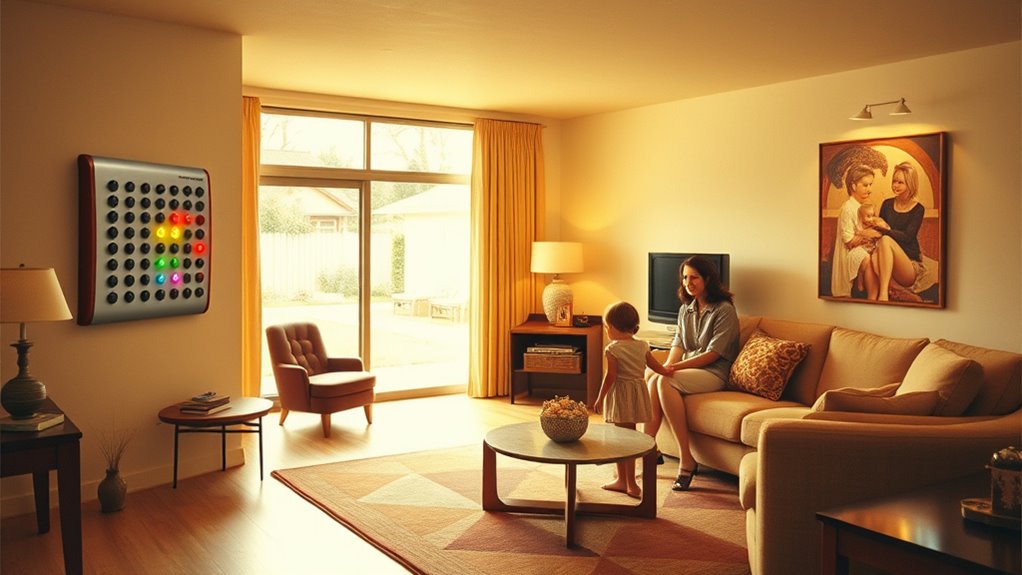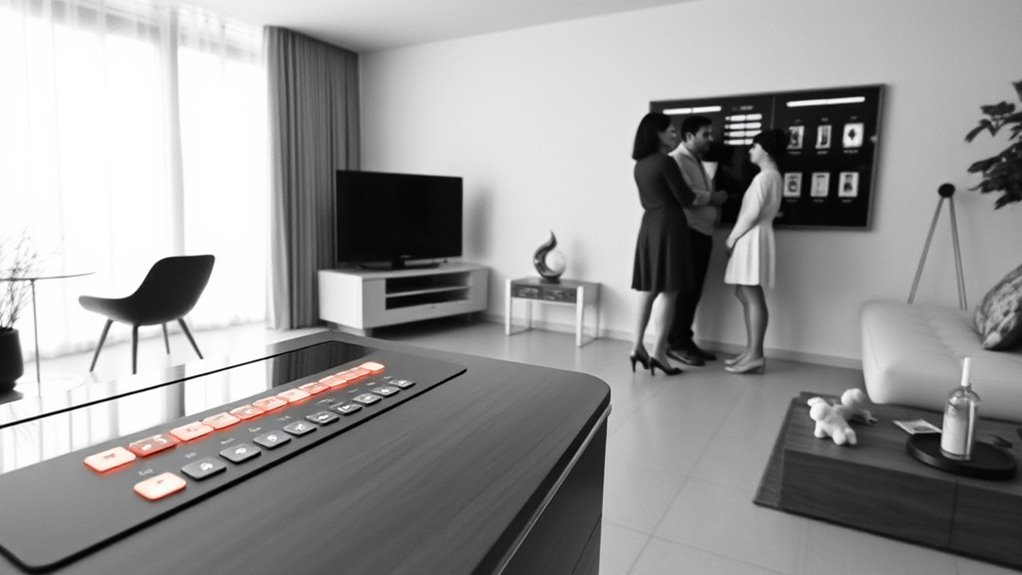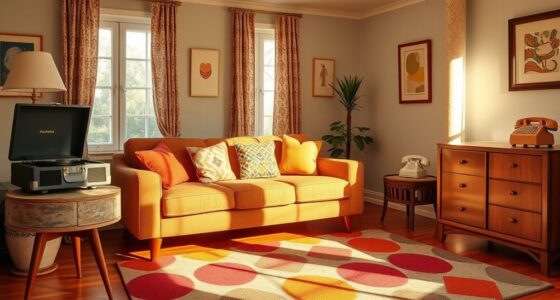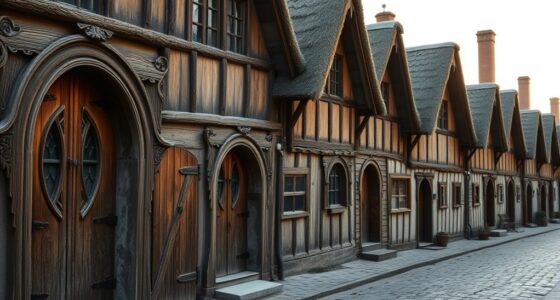In the 1960s, push-button controls sparked dreams of smarter, more convenient homes. People envisioned homes where you could effortlessly manage lighting, appliances, and systems with a simple push of a button. While technology was still in its infancy and often unreliable, designers aimed to blend automation seamlessly with stylish home aesthetics. This era’s innovations set the stage for today’s advanced smart homes. Continuing further reveals how these early ideas influenced modern home automation.
Key Takeaways
- The 1960s envisioned smart homes with push-button controls for lighting, appliances, and household systems.
- Early automation focused on convenience but faced reliability and integration challenges due to technological infancy.
- Designers aimed for discreet, sleek interfaces to blend automation seamlessly into modern home aesthetics.
- Pioneering experiments emphasized the importance of combining functionality with attractive design.
- These foundational efforts laid the groundwork for future advancements toward fully integrated, user-friendly smart homes.

Although the concept of a fully automated home might seem like a modern dream, the 1960s laid early groundwork for what we now call “smart homes.” During this decade, innovative appliances and systems began to emerge, offering homeowners new levels of convenience and control. You might have been inspired by futuristic visions of push-button living, where flicking a switch or pressing a button could control various household functions seamlessly. Yet, these early efforts faced significant automation challenges. Engineers and designers grappled with integrating multiple systems into a cohesive, reliable network. The technology was in its infancy, often unreliable, and prone to malfunctions that could frustrate users. As a result, many early automation systems were limited in scope, focusing on simple tasks like controlling lighting or appliances with push buttons or switches. Despite these hurdles, the desire for greater convenience fueled innovation, leading to the development of more sophisticated control panels and remote systems. Additionally, the need for reliable automation technology prompted ongoing research and experimentation during this era.
At the same time, designers faced the challenge of balancing automation with aesthetics. You’d want your home to look stylish and inviting, not cluttered with bulky control panels or unsightly wiring. During the 1960s, there was a strong emphasis on modern design aesthetics that favored clean lines, space-age materials, and futuristic motifs. Architects and interior designers sought to incorporate automation technology discreetly, ensuring that technological elements didn’t detract from the home’s visual appeal. They experimented with integrated paneling, sleek switches, and minimalist interfaces to blend functionality with style. This effort to harmonize technology with design aesthetics helped set the stage for future innovations in home automation, emphasizing that smart systems should enhance, not disrupt, the visual harmony of living spaces.
While the technology of the 1960s wasn’t as advanced as today’s systems, it proved that automation could improve daily life. Early pioneers understood that convenience, combined with attractive design, was key to widespread acceptance. These initial experiments laid the groundwork for future developments that would eventually lead to fully integrated, user-friendly smart homes. You can see how far we’ve come, from simple push-button controls to complex voice-activated systems that seamlessly integrate into our daily routines. The 1960s may have faced automation challenges and design constraints, but their innovative spirit sparked a revolution—one that continues to evolve into the smart homes of today.
Frequently Asked Questions
What Were the Main Technological Limitations of 1960S Smart Home Systems?
You’d find the main limitations of 1960s smart home systems in their lack of wireless connectivity, which meant devices relied on wired connections, limiting flexibility and scalability. The user interface was often primitive, with push buttons and manual switches that made automation cumbersome. These technological constraints prevented seamless integration and real-time control, leaving users with limited convenience and customization compared to today’s wireless, intuitive smart home systems.
How Did 1960S Smart Homes Influence Modern Home Automation?
You see, the 1960s smart homes paved the way for today’s home automation, inspiring innovations like voice control and sleek aesthetic design. Though limited by technology back then, their vision of integrated, convenient living motivated modern developments. Today, you benefit from seamless voice commands and stylish systems that make your home smarter and more comfortable, building on the bold ideas of those early dreamers.
Were 1960S Smart Homes Affordable for the Average Family?
Imagine you’re dreaming of a home where everything’s automated, but the cost considerations in the 1960s made it seem out of reach. Back then, societal perceptions saw smart homes as luxury gadgets, not for everyday families. The technology was expensive and complex, so most couldn’t afford it. For the average family, these homes remained a futuristic dream, highlighting how affordability and societal views shape technology adoption.
What Safety Concerns Existed With Early Push-Button Home Controls?
You might worry about safety with early push-button home controls, as fire hazards and accidental activation were real concerns. These systems often lacked advanced safety features, so buttons could be triggered unintentionally, leading to potential fires or equipment damage. Without modern safeguards, you had to be cautious to prevent accidents, especially since technology was still evolving and didn’t always account for all safety risks associated with automated controls.
How Did Cultural Attitudes Towards Technology Affect Smart Home Adoption?
You might notice that cultural attitudes greatly influence smart home adoption. When there’s cultural optimism, people embrace new technology, enthusiastic to enjoy modern comforts. Conversely, if there’s technological skepticism, you may hesitate, fearing loss of control or privacy. These attitudes shape how quickly and widely smart homes become popular, as society’s confidence or doubts about technology directly impact your willingness to adopt innovative home systems.
Conclusion
Imagine living in a world where over 60% of homes featured push-button controls, making daily tasks effortless. Back in the 1960s, smart homes weren’t just a dream—they were a glimpse into the future. You’d press a button to turn on your lights or start your music, experiencing convenience before it became mainstream. It’s fascinating to see how those early innovations paved the way for today’s connected living, blending technology seamlessly into your everyday life.








